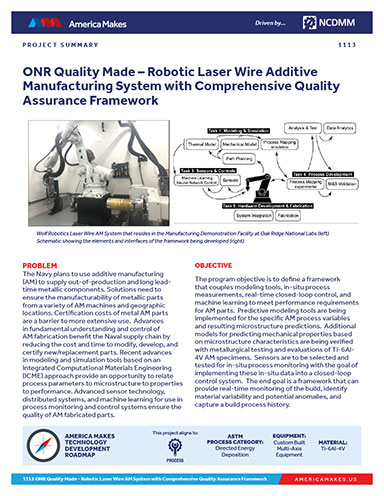ONR Quality Made – Robotic Laser Wire Additive Manufacturing System
Recent advances in modeling and simulation tools based on an Integrated Computational Materials Engineering (ICME) approach provide an opportunity to relate process parameters to microstructure to properties to performance.

March 11, 2019
PROBLEM
The Navy plans to use additive manufacturing (AM) to supply out-of-production and long leadtime metallic components. Solutions need to ensure the manufacturability of metallic parts from a variety of AM machines and geographic locations. Certification costs of metal AM parts are a barrier to more extensive use. Advances in fundamental understanding and control of
AM fabrication benefit the Naval supply chain by reducing the cost and time to modify, develop, and certify new/replacement parts.
Recent advances in modeling and simulation tools based on an Integrated Computational Materials Engineering (ICME) approach provide an opportunity to relate process parameters to microstructure to properties to performance. Advanced sensor technology, distributed systems, and machine learning for use in process monitoring and control systems ensure the quality of AM fabricated parts.
OBJECTIVE
The program objective is to define a framework that couples modeling tools, in-situ process measurements, real-time closed-loop control, and machine learning to meet performance requirements for AM parts. Predictive modeling tools are being implemented for the specific AM process variables and resulting microstructure predictions.
Additional models for predicting mechanical properties based on microstructure characteristics are being verified with metallurgical testing and evaluations of Ti-6Al- 4V AM specimens. Sensors are to be selected and tested for in-situ process monitoring with the goal of implementing these in-situ data into a closed-loop control system. The end goal is a framework that can provide real-time monitoring of the build, identify material variability and potential anomalies, and capture a build process history.
Fill out the information below to download the resource.
Latest News









